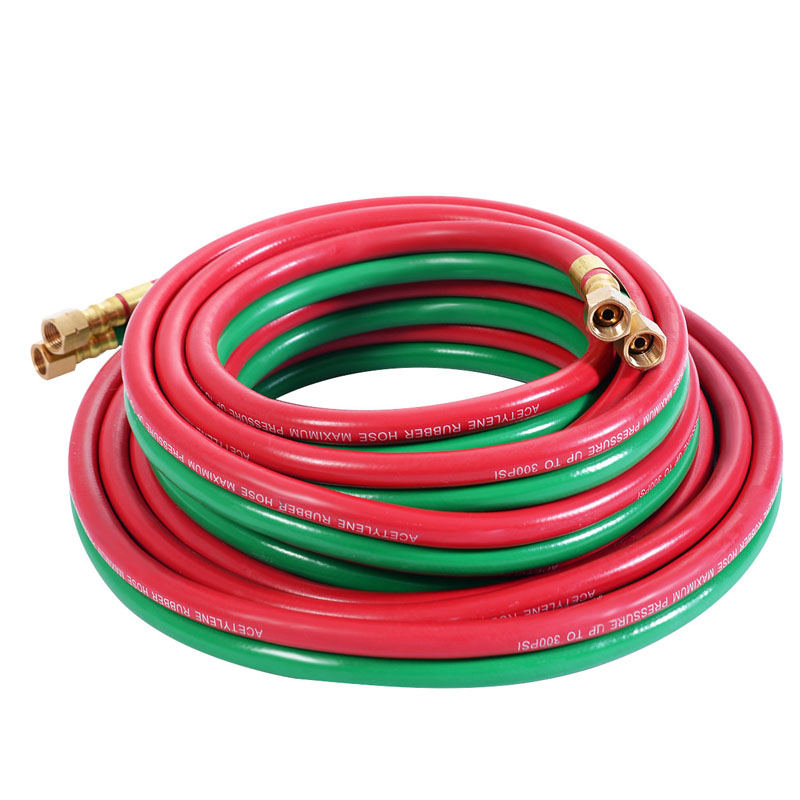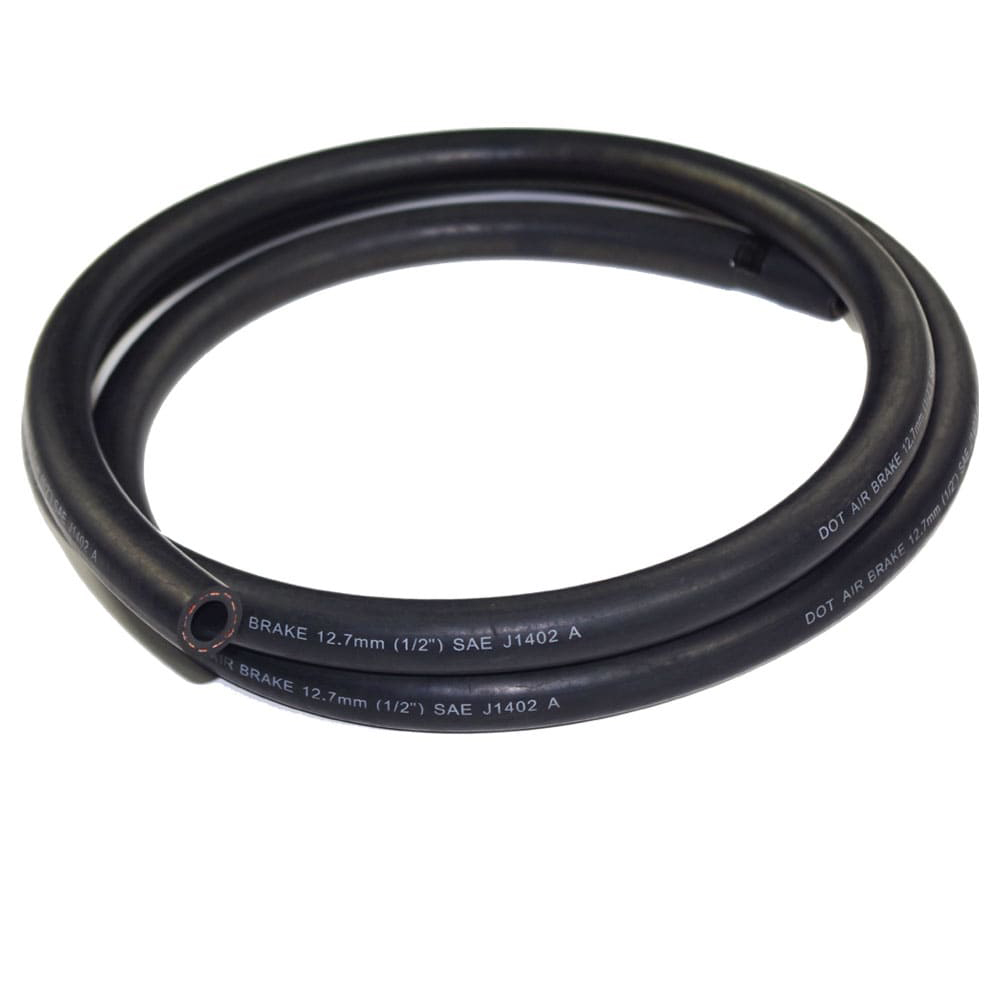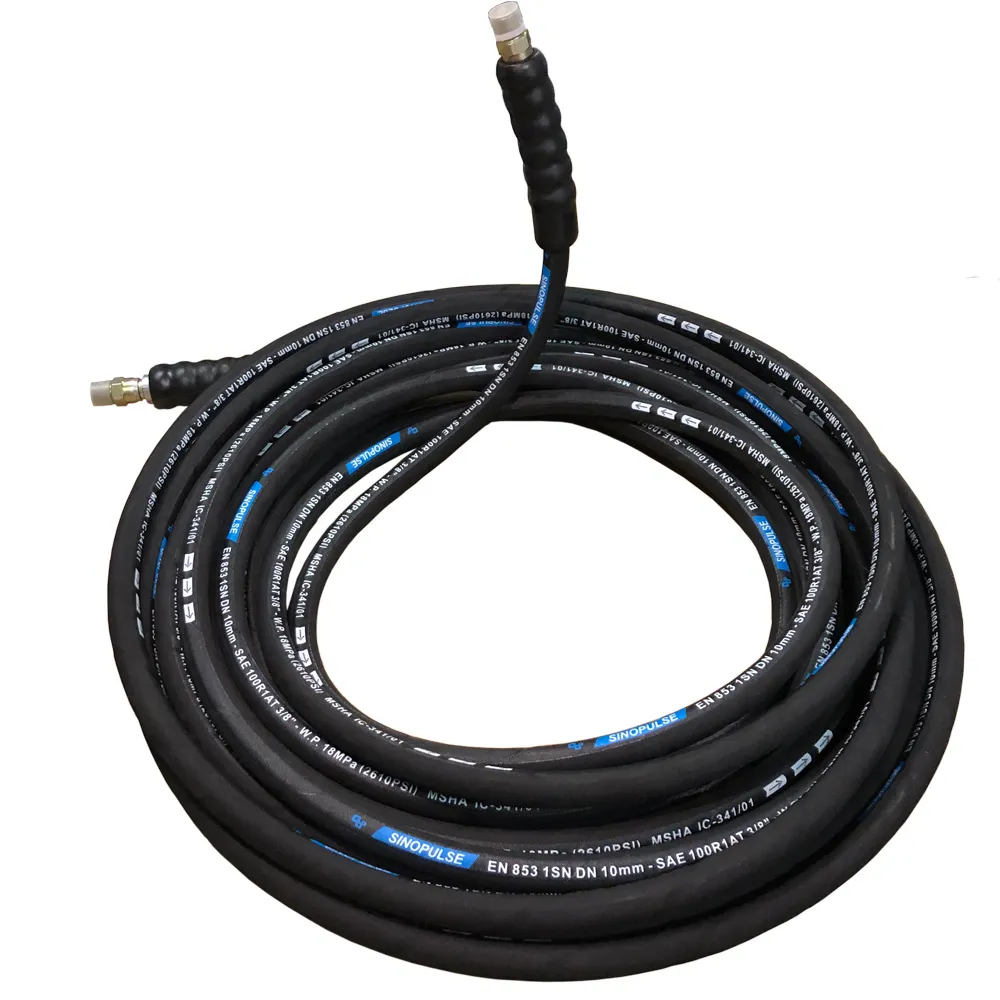Tubu di saldatura
Un tubu di saldatura hè un tipu di tubu flexible pensatu per trasportà in modu sicuru i gasi utilizati in a saldatura, u taglio è altri prucessi industriali. Sti tubi sò specificamente pensati per trattà l'ambienti à alta pressione è alta temperatura, facenu ideali per l'usu cù gasi cum'è l'ossigenu, l'acetilene, u propanu è altri gasi di carburante utilizati in applicazioni di saldatura. A custruzzione di tubi di saldatura include tipicamente un materiale di gomma durabile o termoplasticu chì hè resistente à l'usura, u calore è l'esposizione chimica. À l'internu di a manguera, ci sò generalmente duie linee distinte: una per l'ossigenu è una altra per u gasu di carburante, assicurendu chì ùn si mischianu micca. I tubi di saldatura sò cumunimenti usati in industrii cum'è a fabbricazione di metalli, a custruzzione, a riparazione di l'automobile, a custruzione navale è a manutenzione. Sò vitali per furnisce in modu sicuru i gasi à torce di saldatura è strumenti di taglio, chì furnisce a fiamma necessaria per i travaglii cum'è a brasatura, a saldatura o i metalli di taglio di fiamma. I tubi sò pensati per prevene perdite, pieghe, o rotture chì puderanu causà accidenti periculosi durante l'usu. I tubi di saldatura venenu in diverse dimensioni è lunghezze per accoglie diverse configurazioni di saldatura, è a so custruzzione assicura chì ponu sustene l'alte pressioni è e temperature tipiche di l'operazione di saldatura. Cù e so capacità duali scopi è un design robustu, i tubi di saldatura ghjucanu un rolu cruciale per assicurà a sicurezza, l'efficienza è l'efficacità in a lavorazione di metalli è altri prucessi industriali.
Chì sò e caratteristiche chjave per cunsiderà quandu selezziunate una manguera di saldatura?
Quandu sceglite un tubu di saldatura, parechje caratteristiche chjave deve esse cunsideratu per assicurà chì hè adattatu per l'applicazione di saldatura specifica. Unu di i fatturi più impurtanti hè u materiale di a manguera, perchè deve esse durable è resistente à u calore, l'abrasione è l'esposizione chimica. A maiò parte di i tubi di saldatura sò fatti di gomma o di materiali termoplastici, chì offrenu flessibilità è resistenza à l'usura è mantene a so integrità in cundizioni d'alta temperatura. A manguera deve ancu esse capace di manighjà pressioni elevate, postu chì i gasi di saldatura sò spessu almacenati è trasportati sottu una pressione significativa. Hè indispensabile di sceglie un tubu cù a valutazione di pressione adatta per prevene a rottura o fallimentu durante l'usu. Inoltre, i tubi di saldatura sò tipicamente cuncepiti cù duie linee separati - una per l'ossigenu è l'altru per u gasu di carburante - assicurendu chì i gasi fermanu separati è ùn si mischianu micca, chì puderanu purtà à situazioni periculose. A tappa esterna di a manguera deve ancu esse resistente à fatturi esterni, cum'è l'abrasione, i raghji UV è e cundizioni climatichi, cum'è i tubi di saldatura sò spessu usati in ambienti esterni. A lunghezza è u diametru di a manguera deve esse sceltu secondu i bisogni di u prucessu di saldatura è a distanza trà a fonte di gas è u situ di saldatura. Inoltre, a cumpatibilità cù i tipi specifichi di gasi utilizati hè critica. Per esempiu, i tubi utilizati per u serviziu di l'ossigenu deve esse qualificatu per l'usu di l'ossigenu è ùn deve micca cuntene materiali chì puderanu reagisce cù l'ossigenu, cum'è oliu o grassu. Infine, hè impurtante di verificà per qualsiasi certificazioni di l'industria o u rispettu di i normi di sicurità, cum'è quelli di OSHA o l'Associazione Naziunale di Proteczione di u focu (NFPA), per assicurà chì a manguera risponde à i criteri di sicurezza necessarii per l'applicazioni di saldatura.
Cumu deve esse manteni è conservati i tubi di saldatura per assicurà a sicurezza?
U mantenimentu è u almacenamentu propiu di i tubi di saldatura sò essenziali per assicurà a sicurezza è a longevità durante l'usu. L'ispezioni regulare di i tubi deve esse realizatu per verificà segni di usura, cum'è tagli, abrasioni, crepe, o perdite, soprattuttu vicinu à i raccordi o induve a manguera entra in cuntattu cù oggetti taglienti o superfici ruvide. I tubi di saldatura di gomma, un tipu populari in u mercatu, sò ancu sottumessi à sti cuntrolli.
Se qualchì dannu si trova in una manguera di saldatura, deve esse immediatamente rimpiazzata per evità periculi potenziali. Per prevene u fallimentu di u tubu, assicuratevi chì u tubu hè utilizatu in i so limiti di pressione è di temperatura specificati, postu chì u sopra à questi paràmetri pò purtà à una ruptura. Dopu ogni usu, hè essenziale per almacenà bè i tubi di saldatura, s'ellu sò da un famosu fabricatore di tubi di saldatura o micca, in una zona pulita è secca, luntanu da a luce diretta di u sole, temperature estreme, o chimichi chì puderanu degradà u materiale.
I tecnichi di saldatura di a manguera pò a volte affettanu l'integrità di a manguera, per quessa, hè impurtante prestu attenzione à questi aspetti durante l'ispezione. Coiling the hose loosely is crucial to prevent kinks or bends, cum'è curve sharp ponu debilitatu a manguera è riduce a so vita. Quandu si guarda i tubi di saldatura, assicuratevi chì sò appiccicati o disposti piattamente invece di arrotolati troppu stretti.
Inoltre, a manguera di saldatura deve esse mantene senza contaminanti, soprattuttu oliu, grassu, o altre sustanzi chì puderanu reagisce cù i gasi chì sò trasferiti, in particulare in tubi d'ossigenu, induve ancu una piccula quantità di contaminazione pò creà una situazione periculosa. Se a manguera di saldatura hè esposta à un usu pesante o ambienti duri, a pulizia regulare è u mantenimentu deve esse realizatu per sguassà ogni accumulazione di contaminanti.
Prima di ogni usu, hè impurtante cuntrollà tutti i raccordi è e cunnessione di u tubu di saldatura per assicurà chì sò attaccati in modu sicuru è senza perdite. L'usu di bobine di tubi o ganci di almacenamentu pò ancu aiutà à urganizà i tubi è impediscenu i danni da aggrovigliamenti o abrasioni. Seguendu queste pratiche di mantenimentu è almacenamentu, i tubi di saldatura mantenenu a so sicurezza, affidabilità è prestazione, assicurendu un ambiente di travagliu sicuru per l'operatori.
Twin-line Structure and Safety Design Principles: Welding Hoses
SINOPULSE revolutionizes industrial safety through the engineering of twin welding hoses with a cutting-edge dual-chamber structure. Engineered for precision and reliability, our rubber twin welding hoses address the critical need for safe gas separation in high-risk welding and cutting operations, setting a new standard for performance and protection.
At the heart of SINOPULSE’s welding hoses lies a dual-channel architecture, featuring independent inner tubes dedicated to oxygen and combustible gases such as acetylene or propane. This physical separation is not merely a design choice but a safety imperative: by preventing the mixing of explosive gas combinations, it eliminates the risk of catastrophic ignition within the hose itself. The oxygen chamber, constructed from premium rubber compounds, adheres to strict non-oil and non-grease standards, ensuring compliance with oxygen service safety protocols. Meanwhile, the gas chamber is formulated to resist degradation from hydrocarbons, maintaining integrity even under prolonged exposure to aggressive fuel gases.
To fortify this innovative structure, SINOPULSE integrates multiple reinforcement and protection layers. A robust braided layer, typically composed of high-tensile synthetic fibers or stainless steel, wraps around each chamber, providing mechanical strength capable of withstanding working pressures of up to 20 bar and burst pressures exceeding 60 bar. This reinforcement prevents tube collapse or rupture, safeguarding against sudden failures that could endanger operators. The outer cover, crafted from abrasion-resistant rubber, acts as a shield against external threats: it repels sparks, resists flame penetration, and withstands mechanical impacts common in welding environments. Select models also incorporate anti-static properties, dissipating electrical charges to eliminate ignition risks posed by static buildup.
SINOPULSE’s commitment to safety extends beyond material and structural design. Our twin welding hoses adhere to international safety standards, ensuring seamless integration into industrial safety protocols. The dual-chamber design further optimizes performance by maintaining consistent gas flow rates, enabling welders to achieve precise control over flame temperature and cutting precision.
In metal fabrication, shipbuilding, and construction—industries where safety is paramount—SINOPULSE’s rubber twin welding hoses offer a reliable solution that combines advanced engineering with uncompromising protection. Trust in our hoses to deliver both safety and efficiency in every welding operation.
Selection Decision Tree for Welding Hoses by Gas Type
As a trusted welding hose manufacturer, SINOPULSE understands that selecting the right hose depends on the specific gas used in your welding or cutting application. Different gases—oxygen, acetylene, propane, or inert gases like argon—have unique chemical and physical properties, requiring tailored hose designs to ensure safety, efficiency, and compliance. Below is a structured guide to help you choose the ideal twin welding hose or single-line solution for your needs.
1. Oxygen (O₂) Hoses: Prioritize Purity and Non-Reactivity
Oxygen hoses transport compressed oxygen to fuel the welding flame, making material compatibility critical. SINOPULSE’s rubber twin welding hoses for oxygen feature:
Non-Oil, Non-Grease Inner Tubes: Constructed from premium EPDM or neoprene rubber to prevent hydrocarbon contamination, which can cause explosive reactions with pure oxygen.
Flame-Resistant Outer Covers: Engineered to withstand sparks and radiant heat, reducing fire risks in high-temperature work environments.
Pressure Ratings: Working pressures up to 20 bar (290 PSI) to meet standard oxygen service requirements, with burst pressures exceeding 60 bar (870 PSI) for safety redundancy.
2. Acetylene (C₂H₂) Hoses: Resist Hydrocarbon Degradation
Acetylene, a highly flammable gas, requires hoses that can withstand its reactive nature and low working pressures (typically ≤1 bar). Key selection criteria for SINOPULSE acetylene hoses include:
Hydrocarbon-Resistant Compounds: Inner tubes made from butyl rubber or chloroprene to prevent swelling or cracking caused by acetylene exposure.
Anti-Static Properties: Optional conductive layers to dissipate static charges, a critical safety feature for preventing ignition in volatile environments.
Color Coding: Mandatory red outer covers for easy identification, aligning with international safety standards for acetylene lines.
Flexibility in Low Temperatures: Maintains pliability down to -20°C, ensuring reliable performance in cold climates or outdoor welding.
3. Propane (C₃H₈) and Natural Gas Hoses: Balance Pressure and Flexibility
Used in cutting and heating applications, propane hoses must handle moderate pressures (up to 5 bar) while resisting cold brittleness. SINOPULSE solutions offer:
Low-temperature Resistant Formula: Specialized thermoplastic rubber (TPR) inner tubes that remain flexible at -40°C, ideal for construction or agricultural welding in frigid conditions.
Abrasion-Resistant Outer Layers: Thickened rubber covers to withstand rough handling on job sites, where hoses may drag over gravel, metal, or concrete.
Leak-Proof Fittings: Compatibility with propane-specific connectors to minimize gas loss and ensure secure connections during high-demand operations.
4. Inert Gases (Argon, Helium): Ensure Purity for TIG/WIG Welding
For TIG (Tungsten Inert Gas) welding, where gas purity is essential for weld quality, SINOPULSE recommends:
High-Purity Inner Tubes: Smooth-bore polyethylene or silicone liners that prevent gas contamination, critical for welding stainless steel or aluminum.
Low Permeability Design: Multi-layer construction to minimize gas diffusion, ensuring consistent shielding gas flow and reducing porosity in welds.
Lightweight Construction: Braided synthetic fiber reinforcement for easy maneuverability during precision welding tasks that require fine control.
Key Decision Factors Across All Gases
Gas Compatibility: Always verify that the hose’s inner tube material is rated for your specific gas (e.g., acetylene requires non-copper alloys in fittings to avoid acetylide formation).
Pressure vs. Temperature: Match the hose’s working pressure (e.g., low-pressure acetylene vs. high-pressure oxygen) and temperature range (-40°C to +80°C for most models).
Environmental Hazards: Choose anti-UV covers for outdoor use, spark-resistant layers for proximity to welding arcs, or chemical-resistant coatings for industrial environments with corrosive agents.
Dual vs. Single Chamber: Twin welding hoses are ideal for oxy-fuel setups requiring parallel oxygen and gas lines, while single-line hoses suit inert gas or standalone fuel systems.
Trust SINOPULSE for Tailored Solutions
With decades of expertise in welding hose engineering, SINOPULSE offers a comprehensive range of rubber twin welding hoses and single-line products, each designed to meet the unique demands of your gas type and application. Our team can help you navigate certifications, material specifications, and custom fittings to ensure your welding system operates safely and efficiently.
Contact us today to discuss how our precision-engineered hoses can elevate your welding operations.












